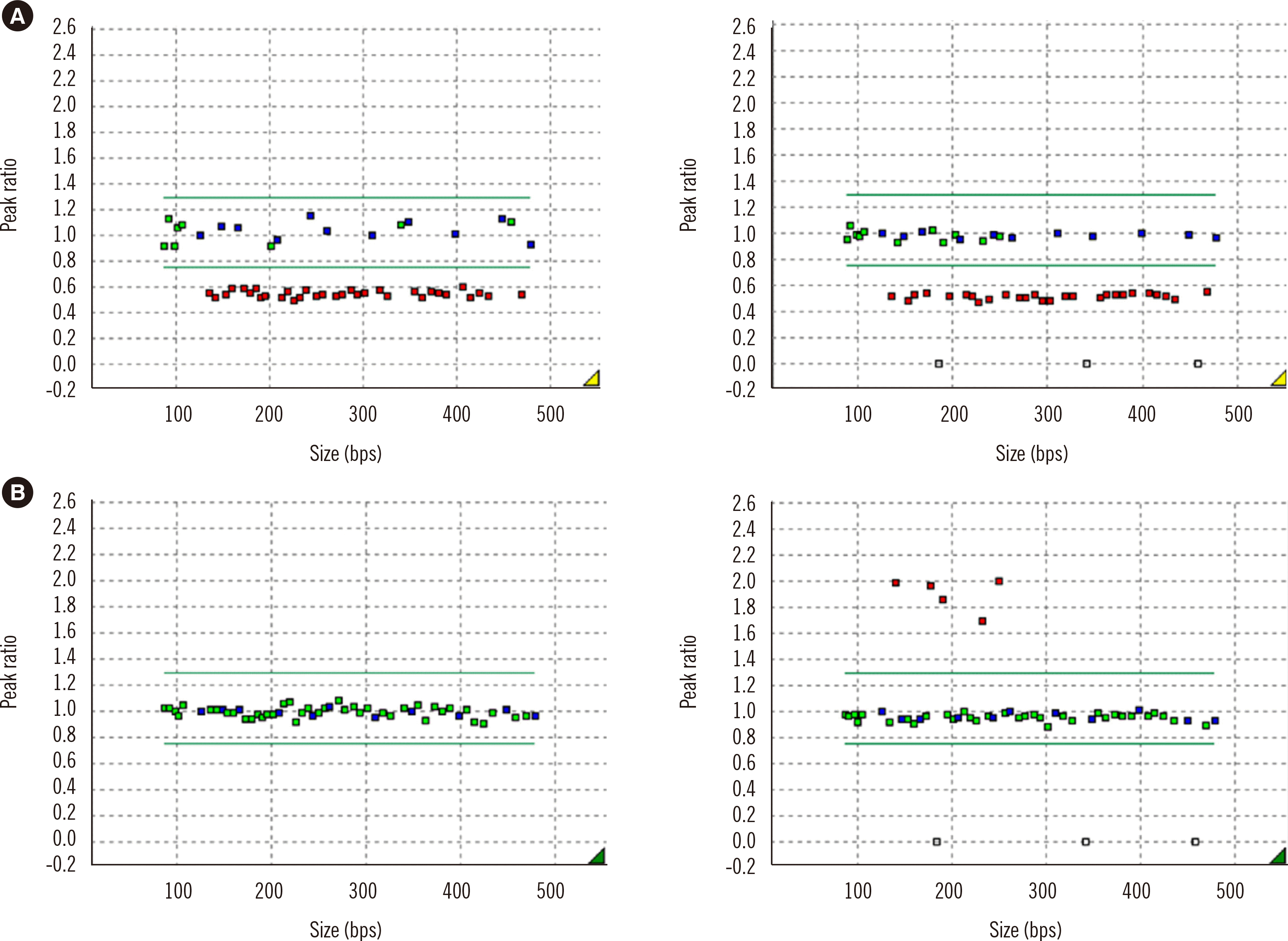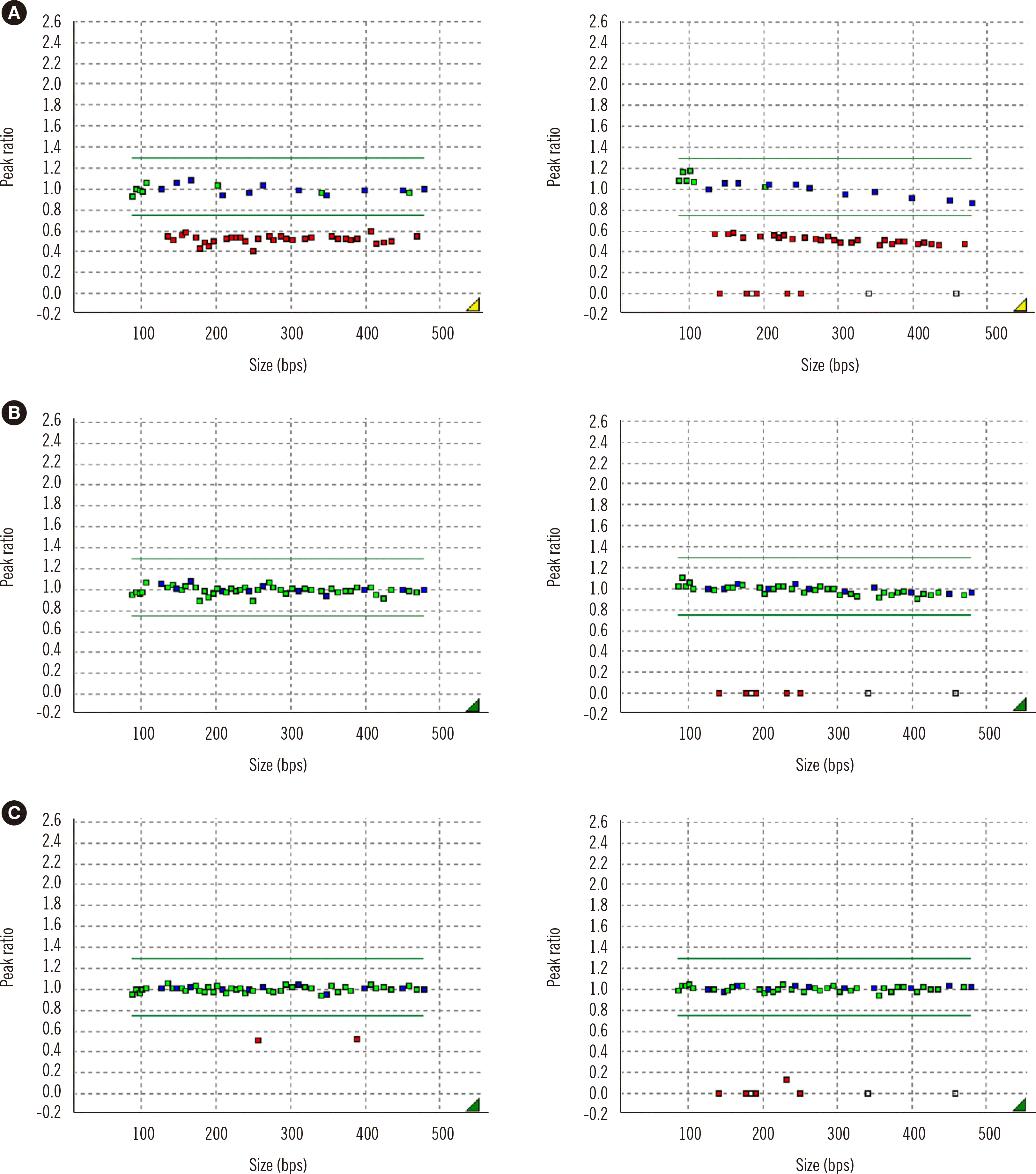1. Õiglane-Shlik E, Talvik T, Zordania R, Põder H, Kahre T, Raukas E, et al. 2006; Prevalence of Angelman syndrome and Prader-Willi syndrome in Estonian children: sister syndromes not equally represented. Am J Med Genet A. 140:1936–43. DOI:
10.1002/ajmg.a.31423. PMID:
16906556.

2. Botezatu A, Puiu M, Cucu N, Diaconu CC, Badiu C, Arsene C, et al. 2016; Comparative molecular approaches in Prader-Willi syndrome diagnosis. Gene. 575:353–8. DOI:
10.1016/j.gene.2015.08.058. PMID:
26335514.

3. Ferreira IR, Costa RA, Gomes LHF, Dos Santos Cunha WD, Tyszler LS, Freitas S, et al. 2020; A newborn screening pilot study using methylation-sensitive high resolution melting on dried blood spots to detect Prader-Willi and Angelman syndromes. Sci Rep. 10:13026. DOI:
10.1038/s41598-020-69750-0. PMID:
32747801. PMCID:
PMC7400512.

4. Ehrhart F, Janssen KJM, Coort SL, Evelo CT, Curfs LMG. 2019; Prader-Willi syndrome and Angelman syndrome: visualisation of the molecular pathways for two chromosomal disorders. World J Biol Psychiatry. 20:670–82. DOI:
10.1080/15622975.2018.1439594. PMID:
29425059.

5. Holm VA, Cassidy SB, Butler MG, Hanchett JM, Greenswag LR, Whitman BY, et al. 1993; Prader-Willi syndrome: consensus diagnostic criteria. Pediatrics. 91:398–402. PMID:
8424017. PMCID:
PMC6714046.

6. Williams CA, Angelman H, Clayton-Smith J, Driscoll DJ, Hendrickson JE, Knoll JH, et al. 1995; Angelman syndrome: consensus for diagnostic criteria. Am J Med Genet. 56:237–8. DOI:
10.1002/ajmg.1320560224. PMID:
7625452.

9. Buiting K. 2010; Prader-Willi syndrome and Angelman syndrome. Am J Med Genet C Semin Med Genet. 154C:365–76. DOI:
10.1002/ajmg.c.30273. PMID:
20803659.

10. Ramsden SC, Clayton-Smith J, Birch R, Buiting K. 2010; Practice guidelines for the molecular analysis of Prader-Willi and Angelman syndromes. BMC Med Genet. 11:70. DOI:
10.1186/1471-2350-11-70. PMID:
20459762. PMCID:
PMC2877670.

12. Nygren AO, Ameziane N, Duarte HM, Vijzelaar RN, Waisfisz Q, Hess CJ, et al. 2005; Methylation-specific MLPA (MS-MLPA): simultaneous detection of CpG methylation and copy number changes of up to 40 sequences. Nucleic Acids Res. 33:e128. DOI:
10.1093/nar/gni127. PMID:
16106041. PMCID:
PMC1187824.

13. Kubota T, Das S, Christian SL, Baylin SB, Herman JG, Ledbetter DH. 1997; Methylation-specific PCR simplifies imprinting analysis. Nat Genet. 16:16–7. DOI:
10.1038/ng0597-16. PMID:
9140389.
14. Shin S, Yu N, Choi JR, Jeong S, Lee KA. 2015; Routine chromosomal microarray analysis is necessary in Korean patients with unexplained developmental delay/mental retardation/autism spectrum disorder. Ann Lab Med. 35:510–8. DOI:
10.3343/alm.2015.35.5.510. PMID:
26206688. PMCID:
PMC4510504.

15. Jang W, Kim Y, Han E, Park J, Chae H, Kwon A, et al. 2019; Chromosomal microarray analysis as a first-tier clinical diagnostic test in patients with developmental delay/intellectual disability, autism spectrum disorders, and multiple congenital anomalies: a prospective multicenter study in Korea. Ann Lab Med. 39:299–310. DOI:
10.3343/alm.2019.39.3.299. PMID:
30623622. PMCID:
PMC6340852.

16. Liu S, Zhang K, Song F, Yang Y, Lv Y, Gao M, et al. 2017; Uniparental disomy of chromosome 15 in two cases by chromosome microarray: a lesson worth thinking. Cytogenet Genome Res. 152:1–8. DOI:
10.1159/000477520. PMID:
28647735.

17. Kim HJ, Cho HJ, Jin DK, Kwon EK, Ki CS, Kim JW, et al. 2004; Genetic basis of Prader-Willi syndrome in Korea: less uniparental disomy than has been recognized? Clin Genet. 66:368–72. DOI:
10.1111/j.1399-0004.2004.00323.x. PMID:
15355442.

18. Butler MG, Hartin SN, Hossain WA, Manzardo AM, Kimonis V, Dykens E, et al. 2019; Molecular genetic classification in Prader-Willi syndrome: a multisite cohort study. J Med Genet. 56:149–53. DOI:
10.1136/jmedgenet-2018-105301. PMID:
29730598. PMCID:
PMC7387113.

19. Singh P, Mahmoud R, Gold JA, Miller JL, Roof E, Tamura R, et al. 2018; Multicentre study of maternal and neonatal outcomes in individuals with Prader-Willi syndrome. J Med Genet. 55:594–8. DOI:
10.1136/jmedgenet-2017-105118. PMID:
29776967. PMCID:
PMC6107376.

20. Kim HE, Song IG, Chung SH, Choi YS, Bae CW. 2019; Trends in birth weight and the incidence of low birth weight and advanced maternal age in Korea between 1993 and 2016. J Korean Med Sci. 34:e34. DOI:
10.3346/jkms.2019.34.e34. PMID:
30686955. PMCID:
PMC6345638.

21. Butler MG, Bittel DC, Kibiryeva N, Talebizadeh Z, Thompson T. 2004; Behavioral differences among subjects with Prader-Willi syndrome and type I or type II deletion and maternal disomy. Pediatrics. 113:565–73. DOI:
10.1542/peds.113.3.565. PMID:
14993551. PMCID:
PMC6743499.

22. Kim SJ, Miller JL, Kuipers PJ, German JR, Beaudet AL, Sahoo T, et al. 2012; Unique and atypical deletions in Prader-Willi syndrome reveal distinct phenotypes. Eur J Hum Genet. 20:283–90. DOI:
10.1038/ejhg.2011.187. PMID:
22045295. PMCID:
PMC3283188.

23. Hassan M, Butler MG. 2016; Prader-Willi syndrome and atypical submicroscopic 15q11-q13 deletions with or without imprinting defects. Eur J Med Genet. 59:584–9. DOI:
10.1016/j.ejmg.2016.09.017. PMID:
27659713. PMCID:
PMC6688621.

24. Kanber D, Giltay J, Wieczorek D, Zogel C, Hochstenbach R, Caliebe A, et al. 2009; A paternal deletion of MKRN3, MAGEL2 and NDN does not result in Prader-Willi syndrome. Eur J Hum Genet. 17:582–90. DOI:
10.1038/ejhg.2008.232.

25. Hartin SN, Hossain WA, Weisensel N, Butler MG. 2018; Three siblings with Prader-Willi syndrome caused by imprinting center microdeletions and review. Am J Med Genet A. 176:886–95. DOI:
10.1002/ajmg.a.38627. PMID:
29437285. PMCID:
PMC6688622.

26. Lu W, Qi Y, Cui B, Chen XL, Wu BB, Chen C, et al. 2014; Clinical and genetic features of Prader-Willi syndrome in China. Eur J Pediatr. 173:81–6. DOI:
10.1007/s00431-013-2124-2. PMID:
23933672.

27. Wang W, Law HY, Chong SS. 2009; Detection and discrimination between deletional and non-deletional Prader-Willi and Angelman syndromes by methylation-specific PCR and quantitative melting curve analysis. J Mol Diagn. 11:446–9. DOI:
10.2353/jmoldx.2009.090015. PMID:
19661385. PMCID:
PMC2729842.

28. Beygo J, Buiting K, Ramsden SC, Ellis R, Clayton-Smith J, Kanber D. 2019; Update of the EMQN/ACGS best practice guidelines for molecular analysis of Prader-Willi and Angelman syndromes. Eur J Hum Genet. 27:1326–40. DOI:
10.1038/s41431-019-0435-0. PMID:
31235867. PMCID:
PMC6777528.







 PDF
PDF Citation
Citation Print
Print




 XML Download
XML Download